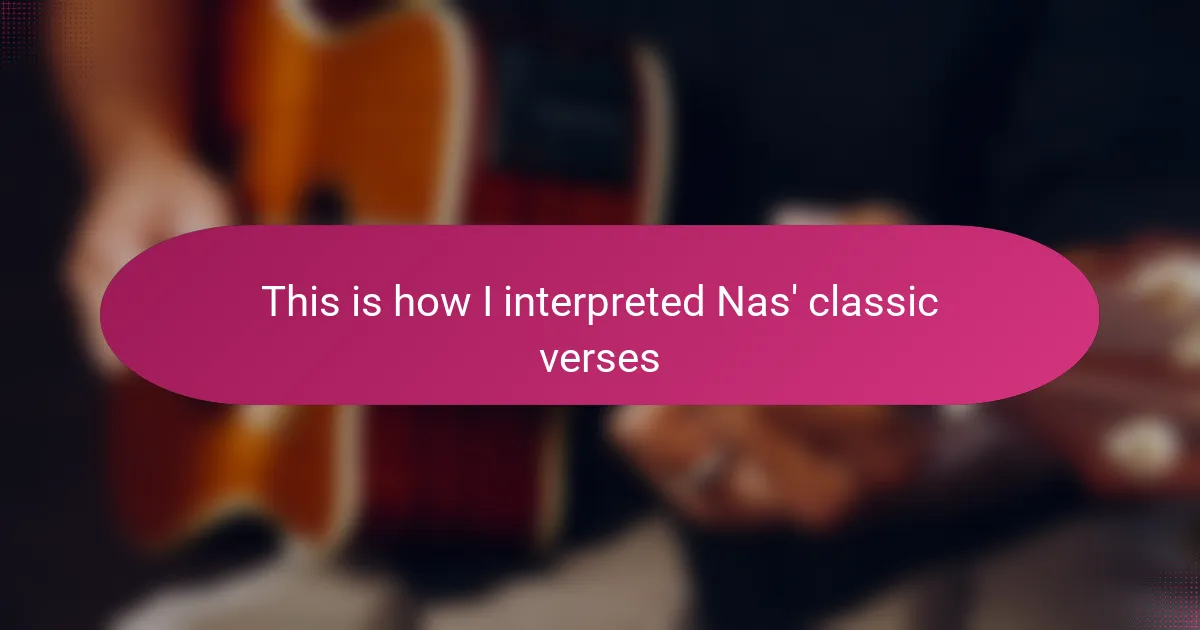Key takeaways
- Classic rap verses, especially by artists like Nas, offer rich narratives that combine personal and universal experiences, requiring attentive listening to appreciate their depth.
- Nas’s lyrical style integrates storytelling with intricate wordplay, prompting listeners to explore hidden meanings and emotional nuances behind his verses.
- The key themes in Nas’s music include struggle, resilience, and social awareness, making his work relevant across different eras and inspiring listeners to reflect on their own experiences.
- Effective interpretation of Nas’s verses involves active listening, connecting lyrics to personal experiences, and analyzing metaphors, enhancing the emotional impact of the music.
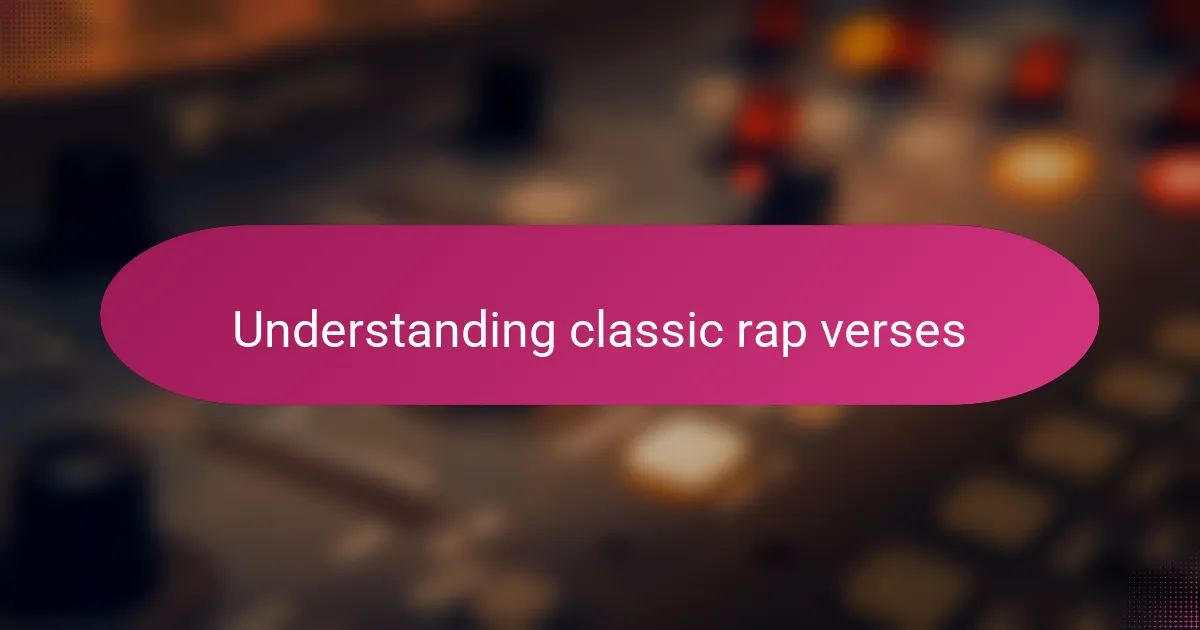
Understanding classic rap verses
Whenever I revisit classic rap verses, I find myself digging beyond the surface, tuning into the emotions and stories that the artist weaves through their words. It’s like hearing history and raw experience all at once, which makes me wonder—how often do we really pause to absorb the depth behind those lines?
I remember the first time I truly listened to a Nas verse without distractions; it felt like he was speaking directly to me, sharing struggles and hopes that felt both personal and universal. That moment opened my eyes to how classic rap isn’t just about clever rhymes—it’s a powerful narrative that demands careful attention.
Isn’t it fascinating how a few lines can carry layers of meaning, cultural context, and poetic devices all at once? Understanding these verses requires patience and curiosity, but the payoff is huge: a richer connection to the artist’s vision and a deeper appreciation for the art form itself.
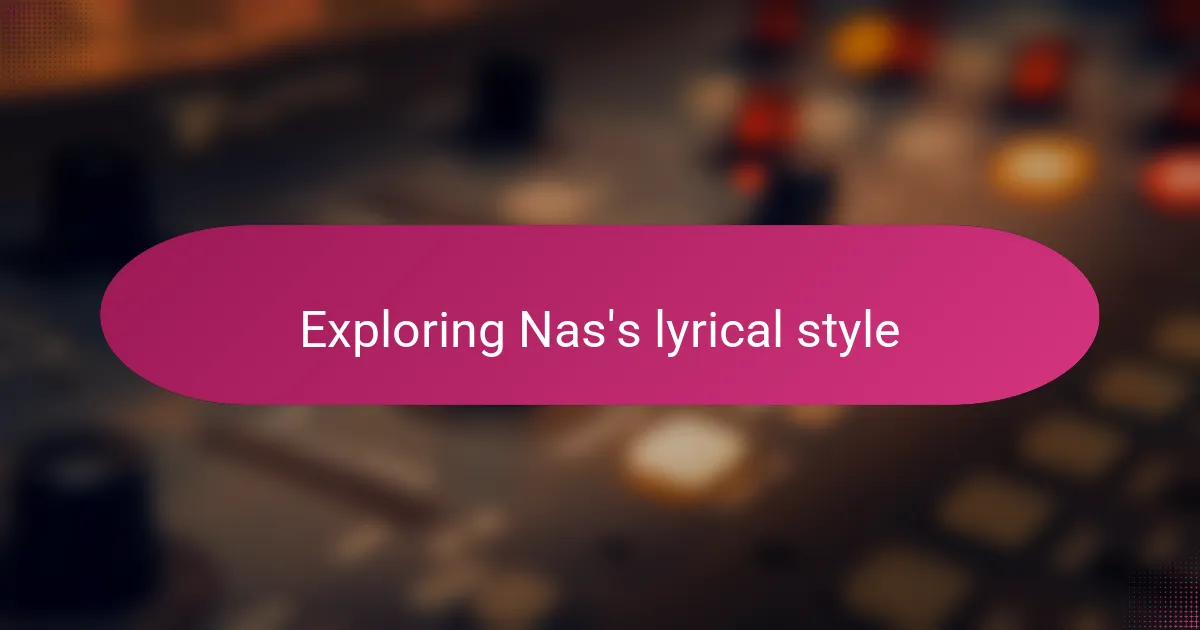
Exploring Nas’s lyrical style
Nas’s lyrical style always strikes me as a brilliant blend of storytelling and intricate wordplay. When I listen closely, I notice how he crafts vivid pictures out of everyday struggles, making his verses feel like chapters in a lived experience. Have you ever caught yourself pausing just to absorb the layers he packs into a single line?
What stands out most to me is how Nas balances raw honesty with poetic finesse. It’s as if he invites you into his world but never hands over the whole story at once—you have to lean in, read between the lines, and unpack the meaning slowly. That subtle complexity is what keeps me coming back; every listen reveals new insights.
Sometimes, I feel like his approach mirrors a conversation with a wise friend who knows the streets but also contemplates larger truths about life. Doesn’t that perspective make you appreciate how much thought and emotion go into his verses? For me, it’s what turns his music into timeless art rather than just songs.
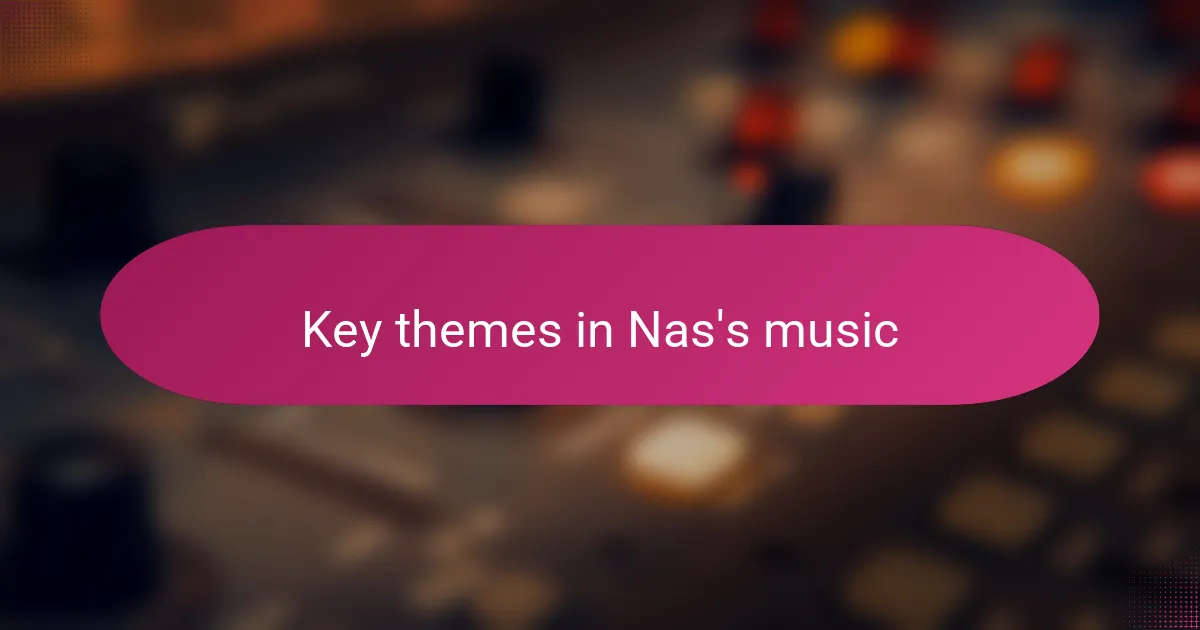
Key themes in Nas’s music
When I dive into Nas’s music, I’m always struck by how themes like struggle and resilience weave through his verses like a lifeline. It’s more than just telling stories about the streets; Nas captures the human spirit’s fight against adversity in a way that feels both intimate and universal. Have you noticed how that theme keeps his music relevant, no matter the era?
Another key theme I find compelling is Nas’s deep social and political awareness. He doesn’t just drop commentary; he challenges listeners to reflect on systemic issues and their impact on everyday life. It’s rare to hear rap that combines personal narrative with sharp social critique so seamlessly, and I think that’s what sets Nas apart for me.
Lastly, there’s this persistent thread of hope and aspiration in his work that I find inspiring. Even when he paints gritty pictures of hardship, there’s always a glimmer of dreaming for something better. That contrast—that push and pull between reality and possibility—resonates deeply and keeps me coming back to his verses again and again.
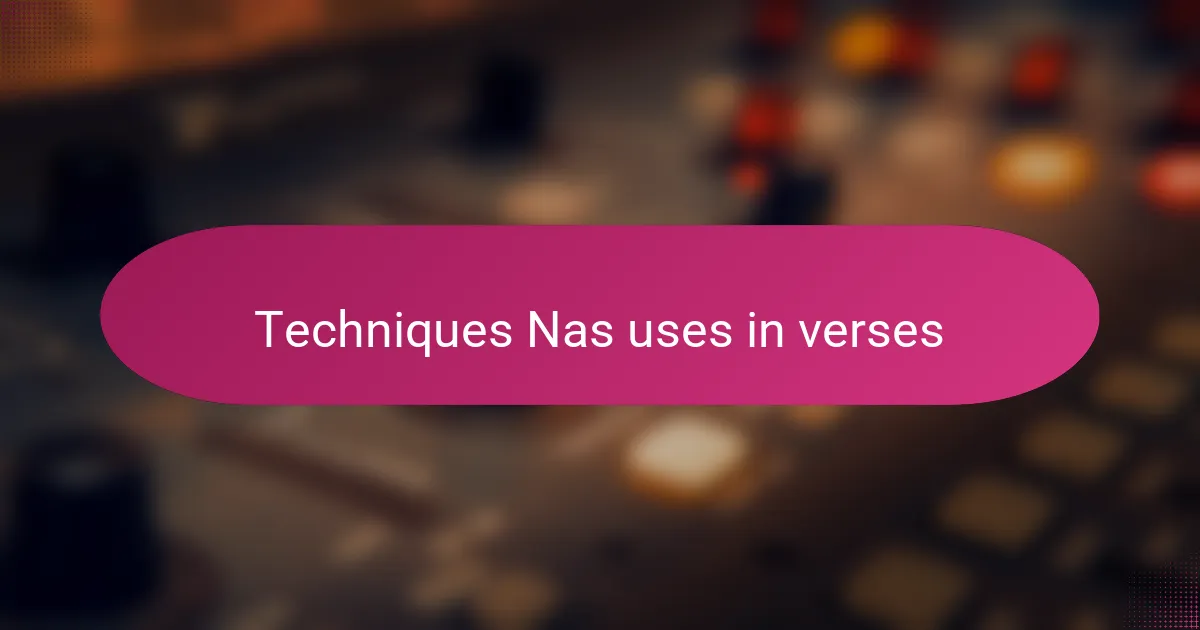
Techniques Nas uses in verses
What really grabs me about Nas’s technique is his use of multisyllabic rhyme schemes that flow so naturally, it feels like a conversation rather than a forced pattern. I remember trying to write lines with that kind of complexity and realizing it’s not just about rhyming but about rhythm and meaning working hand in hand. Isn’t it incredible how he makes complicated rhymes feel effortless and organic?
Another thing I’ve noticed is his masterful use of vivid imagery. Nas doesn’t just tell you what’s happening; he paints scenes with words that pull you right into the moment. For me, those snapshots are like mini-movies playing in my mind, making the stories hit harder and stick longer. Do you ever get that feeling where a single line transports you somewhere so real it’s almost tangible?
Also, Nas often layers metaphors and double entendres in his verses, turning each listen into a puzzle to solve. I find myself rewinding just to catch meanings I missed the first time—there’s always a hidden gem or deeper truth buried beneath the surface. Don’t you love it when a verse reveals new depths after every listen? That’s what keeps Nas’s work endlessly fresh for me.
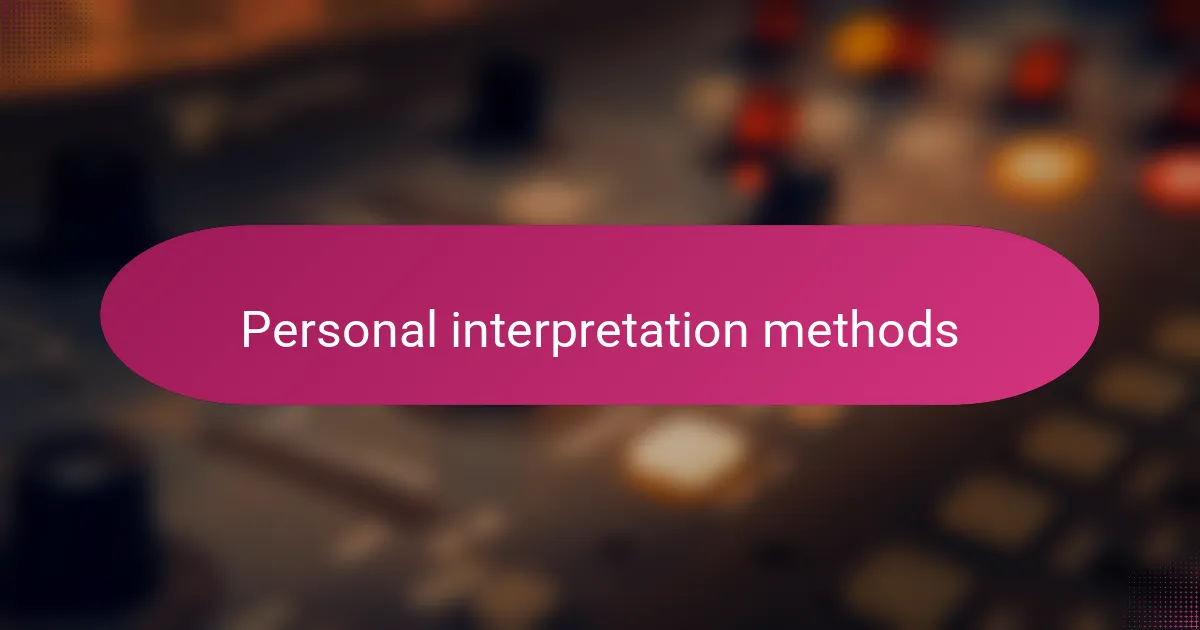
Personal interpretation methods
When I interpret Nas’s verses, my first step is to listen actively, not just hearing but feeling each word. I often pause after a line, letting the emotions settle before moving on. Have you ever tried that? It changes everything—those moments of stillness reveal nuances you’d miss in a casual listen.
I also like to connect the lyrics to my own experiences or observations. Sometimes, a single verse sparks a memory or an insight about life’s complexities. This personal connection makes Nas’s stories hit home in a way that’s both intimate and profound—almost like he’s speaking directly to my own journey.
Then there’s the practice of breaking down his wordplay and metaphors slowly, like peeling layers off an onion. I find that writing down unfamiliar phrases or cultural references helps me dive deeper. Doesn’t it feel rewarding when you unravel a clever line that initially flew over your head? Those ‘aha’ moments are what keep interpreting these classics so exciting for me.
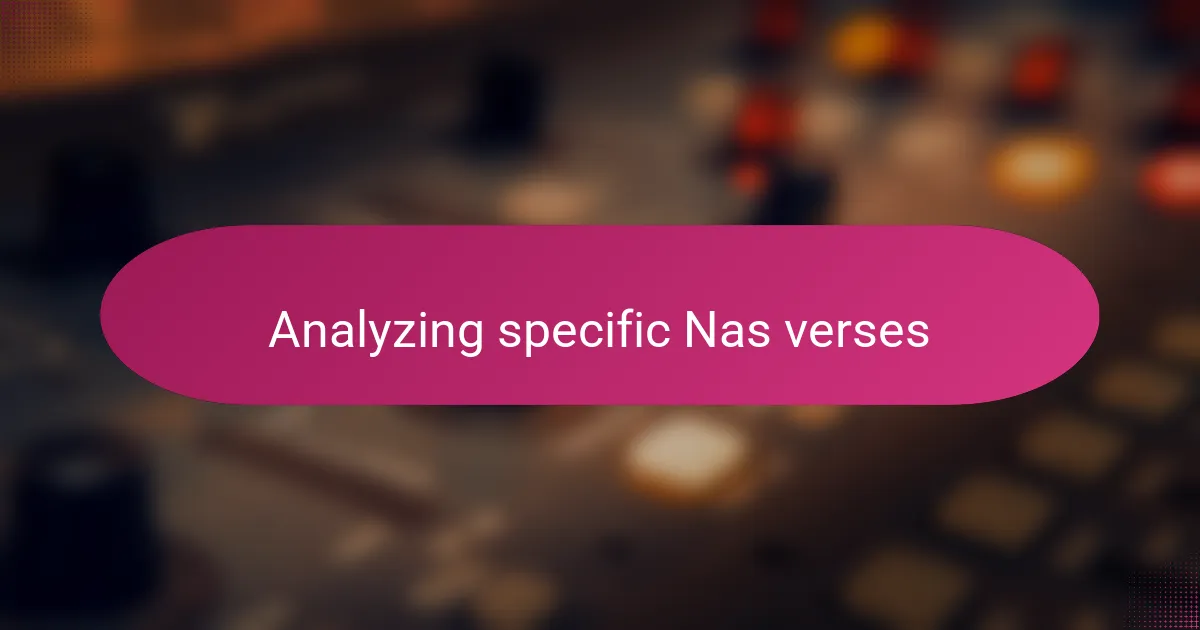
Analyzing specific Nas verses
One verse that always stops me in my tracks is from “It Ain’t Hard to Tell,” where Nas raps, “I exhale the yellow smoke of Buddha through righteous steps.” To me, this line isn’t just about smoking; it’s a vivid metaphor for finding peace and clarity amid chaos. Have you ever felt that moment of calm in a storm? That’s exactly the feeling Nas encapsulates here with such poetic precision.
Then there’s the verse from “One Love,” where Nas writes letters to friends incarcerated, weaving hope and frustration together. When I listen to those lines, I’m reminded of how rap can be a lifeline—a voice to those often unheard. It makes me think about the power of storytelling as a way to maintain connection and humanity, even through prison walls.
I also find myself drawn to the complex internal rhymes in “NY State of Mind,” where every phrase hits like a cinematic snapshot of city life. Breaking down those bars, I’m struck by how Nas captures danger and beauty simultaneously, painting a gritty yet compelling portrait. Isn’t it amazing how such a dense verse can transport you directly into Queensbridge’s streets? That kind of immersive storytelling is what makes analyzing his verses so rewarding.
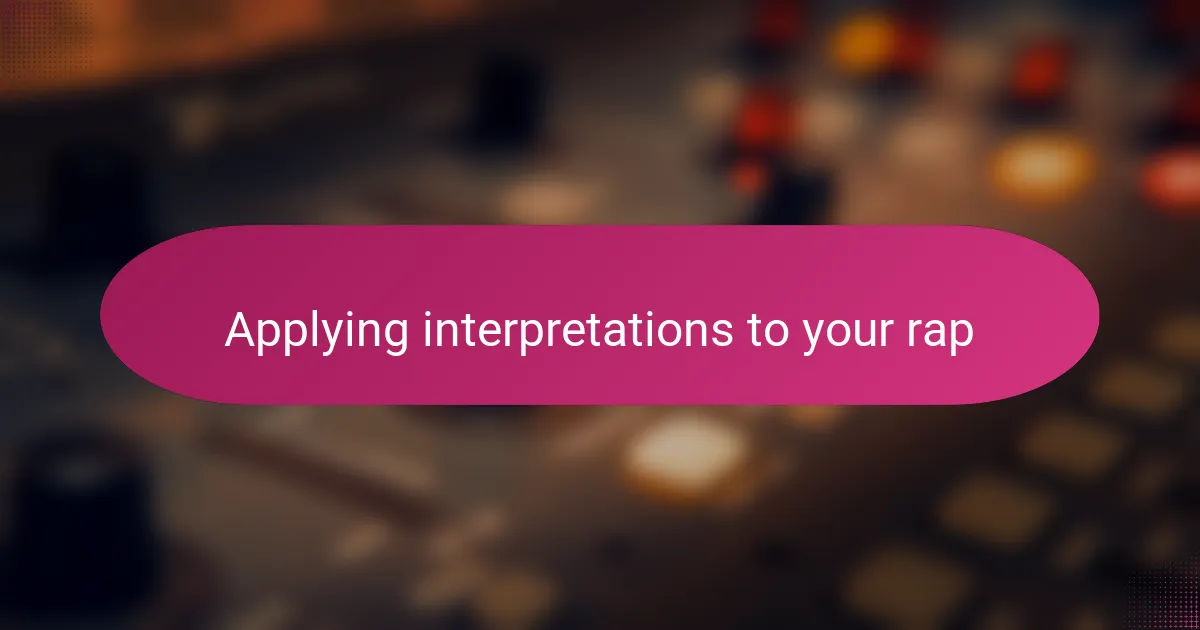
Applying interpretations to your rap
Applying interpretations to your rap is where the real magic happens. I’ve found that when I take a Nas verse and try to channel its emotional weight into my own writing, it pushes me beyond surface-level rhymes. Have you ever noticed how letting a line’s meaning simmer inside you first leads to bars that feel more authentic and layered?
Sometimes, I catch myself borrowing not just the words but the vibe—the mood Nas creates—as I write. It’s like stepping into his shoes for a moment, feeling the struggle or hope he’s conveying, and then translating that feeling into my own story. That process turns my verses from mere lines into something that resonates on a deeper level.
What’s been eye-opening for me is how applying these interpretations challenges me to balance complexity with clarity. Nas’s verses aren’t just puzzles; they’re invitations to connect. So, when I write, I ask myself: am I telling something real, something listeners can feel? That question keeps my rap grounded while still paying homage to the artistry I admire.
